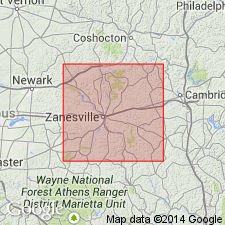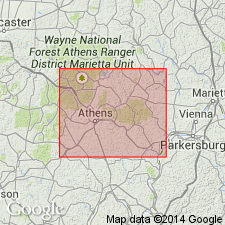
- Usage in publication:
-
- Bloomfield limestone
- Modifications:
-
- Named
- Dominant lithology:
-
- Limestone
- AAPG geologic province:
-
- Appalachian basin
Summary:
Bloomfield limestone, exposed west of Bloomfield, OH, is described as nodular, hard, dense, non-fossiliferous light-gray fresh-water limestone, in places stained with iron oxide. Thickness ranges 0 to 2.5 feet. Lies 3 feet 9 inches below Anderson coal and 8 feet 8 inches above Cambridge limestone in area of report.
Source: GNU records (USGS DDS-6; Reston GNULEX).

- Usage in publication:
-
- Bloomfield limestone member
- Modifications:
-
- Revised
- AAPG geologic province:
-
- Appalachian basin
Summary:
Bloomfield limestone is treated as member of Anderson cyclothem (new) of Conemaugh series. Underlies Anderson clay member; overlies Bakerstown shale and (or) sandstone member. According to Waage (1950: MD Dept. Geology, Mines and Water Resources Bull. 9), Hennen and Reger (1914) named an equivalent limestone in Preston Co., WV, the Albright limestone. Thus, Albright has precedence over Bloomfield. Recommended that Albright replace Bloomfield if and when positive correlation is determined.
Source: GNU records (USGS DDS-6; Reston GNULEX).
For more information, please contact Nancy Stamm, Geologic Names Committee Secretary.
Asterisk (*) indicates published by U.S. Geological Survey authors.
"No current usage" (†) implies that a name has been abandoned or has fallen into disuse. Former usage and, if known, replacement name given in parentheses ( ).
Slash (/) indicates name conflicts with nomenclatural guidelines (CSN, 1933; ACSN, 1961, 1970; NACSN, 1983, 2005, 2021). May be explained within brackets ([ ]).

